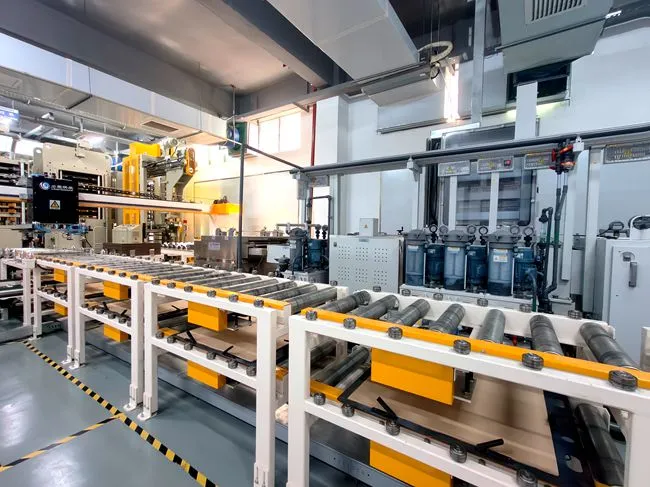The Evolution of SMT PCB Manufacturing Technology
From Through-Hole to Surface Mount Technology
The transition from through-hole to surface mount technology marks a significant milestone in PCB manufacturing. Through-hole technology, while robust, had limitations in terms of board real estate utilization and assembly speed. SMT overcame these challenges by introducing components that could be mounted directly onto the PCB surface, eliminating the need for drilling holes and manual insertion of leads.
This shift allowed for more compact designs and paved the way for miniaturization in electronics. SMT components are typically smaller than their through-hole counterparts, enabling higher component density on PCBs. This not only results in smaller devices but also improves electrical performance by reducing signal path lengths.
Advancements in SMT Equipment and Processes
The rapid evolution of SMT PCB manufacturing has been driven by continuous improvements in equipment and processes. Modern pick-and-place machines can place tens of thousands of components per hour with micron-level accuracy. These machines use advanced vision systems and precise motion control to ensure each component is correctly positioned.
Reflow soldering techniques have also seen significant advancements. Precise temperature control and profiling allow for optimal solder joint formation, ensuring reliable electrical and mechanical connections. The introduction of lead-free solders has further improved the environmental sustainability of SMT processes.
Integration of Artificial Intelligence and Machine Learning
The integration of artificial intelligence (AI) and machine learning (ML) in SMT PCB manufacturing has taken precision and efficiency to new heights. AI-powered systems can optimize component placement patterns, predict and prevent potential defects, and continuously improve process parameters based on historical data.
Machine learning algorithms analyze vast amounts of production data to identify patterns and anomalies that might escape human observation. This leads to proactive maintenance, reduced downtime, and consistent quality output. The combination of AI and SMT technology is pushing the boundaries of what's possible in PCB assembly, enabling the production of increasingly complex and reliable electronic devices.
Enhancing Assembly Speed through SMT Innovations
High-Speed Component Placement Systems
One of the key factors contributing to the increased assembly speed in SMT PCB manufacturing is the development of high-speed component placement systems. These advanced machines can place components at rates exceeding 100,000 components per hour, a significant improvement over manual or older automated systems.
Modern placement machines utilize multiple placement heads, each capable of picking and placing different component types simultaneously. This parallel processing capability, combined with optimized movement patterns, dramatically reduces the time required to populate a PCB. Additionally, advanced feeders and component presentation systems ensure a continuous supply of parts, minimizing downtime and further enhancing production speed.
Automated Optical Inspection (AOI) and X-ray Inspection
While speed is crucial, maintaining quality is equally important. Automated Optical Inspection (AOI) systems play a vital role in ensuring assembly accuracy without sacrificing speed. These systems use high-resolution cameras and sophisticated image processing algorithms to inspect solder joints, component placement, and overall board quality at speeds matching the production line.
For more complex assemblies or components with hidden solder joints, X-ray inspection systems provide an additional layer of quality control. These systems can detect issues such as voids in solder joints or misalignments in ball grid array (BGA) components, which are not visible to optical systems. The integration of these inspection technologies into the SMT process allows for real-time quality control, reducing the need for time-consuming manual inspections and rework.
Efficient Material Handling and Inventory Management
Efficient material handling and inventory management systems are often overlooked aspects of SMT PCB manufacturing that significantly contribute to assembly speed. Advanced material tracking systems using RFID or barcode technology ensure that the right components are available at the right time, reducing production delays due to material shortages or mix-ups.
Just-in-time (JIT) inventory systems, coupled with sophisticated demand forecasting algorithms, help optimize component stock levels. This not only reduces storage costs but also ensures that production lines are consistently supplied with the necessary materials. Automated storage and retrieval systems (AS/RS) further enhance efficiency by quickly and accurately retrieving and delivering components to production lines as needed.
Precision Improvements in SMT PCB Assembly
Advanced Component Alignment Techniques
Precision in SMT PCB Manufacturing and assembly has reached unprecedented levels thanks to advanced component alignment techniques. Modern pick-and-place machines employ sophisticated vision systems that can recognize and align components with micron-level accuracy. These systems use multiple cameras and advanced image processing algorithms to identify component features and ensure precise placement.
For ultra-fine-pitch components or those with hidden solder joints, such as BGAs or QFNs (Quad Flat No-leads), specialized alignment techniques are employed. These may include the use of laser alignment systems or X-ray real-time positioning for ensuring accurate placement of these challenging components. The ability to handle such precise alignments has enabled the production of increasingly complex and densely populated PCBs.
Solder Paste Deposition Control
The precision of solder paste deposition plays a crucial role in the quality of SMT assemblies. Advanced stencil printing systems use closed-loop feedback mechanisms to control paste volume, pressure, and speed. This ensures consistent and precise solder paste deposits, which is critical for forming reliable solder joints, especially for fine-pitch components.
Innovations in stencil technology, such as nano-coated stencils and stepped stencils, allow for better control of solder paste release and enable the printing of different paste volumes for mixed-technology boards. Additionally, 3D solder paste inspection systems provide immediate feedback on paste deposition quality, allowing for real-time adjustments and ensuring consistent solder joint formation.
Thermal Profiling and Reflow Control
Precision in the reflow soldering process is essential for creating reliable solder joints without damaging sensitive components. Advanced reflow ovens use multiple heating zones and sophisticated temperature control systems to create optimal thermal profiles for each PCB design. These profiles are carefully managed to ensure proper solder melting and wetting while avoiding thermal stress on components.
Thermal profiling software allows engineers to simulate and optimize reflow profiles before actual production, reducing setup time and ensuring consistent results. In-line profiling systems monitor the actual temperature of PCBs as they pass through the reflow oven, providing real-time data for process control and quality assurance. This level of thermal management ensures high-quality solder joints and minimizes the risk of thermal damage to components, contributing to the overall precision and reliability of SMT assemblies.
Conclusion
SMT PCB manufacturing has revolutionized the electronics industry by significantly improving assembly speed and precision. The evolution from through-hole to surface mount technology, coupled with advancements in equipment and processes, has enabled the production of more complex and compact electronic devices. High-speed component placement systems, automated inspection technologies, and efficient material handling have dramatically increased assembly speeds.
Simultaneously, precision has been enhanced through advanced component alignment techniques, precise solder paste deposition control, and sophisticated thermal profiling in reflow soldering. The integration of AI and machine learning further optimizes these processes, pushing the boundaries of what's achievable in PCB assembly.
As SMT technology continues to evolve, we can expect even greater improvements in speed and precision, enabling the development of next-generation electronic devices that are smaller, more powerful, and more reliable than ever before. The future of SMT PCB manufacturing looks promising, with ongoing innovations set to drive further advancements in the electronics industry.
FAQ
What are the main advantages of SMT PCB manufacturing?
SMT PCB manufacturing offers increased assembly speed, higher component density, improved precision, and the ability to create more compact and complex electronic devices.
How does SMT improve assembly precision?
SMT improves precision through advanced component alignment techniques, precise solder paste deposition control, and sophisticated thermal profiling in reflow soldering.
Can SMT be used for all types of electronic components?
While SMT is suitable for most modern components, some specialized or high-power components may still require through-hole technology. Many PCBs use a combination of SMT and through-hole components.
Experience the Benefits of Advanced SMT PCB Manufacturing | Ring PCB
At Ring PCB, we leverage cutting-edge SMT PCB manufacturing techniques to deliver superior quality and efficiency. Our state-of-the-art facility, equipped with high-speed placement machines and advanced inspection systems, ensures rapid and precise assembly of your PCBs. With our team of over 500 professionals and ISO-certified quality control, we guarantee exceptional results for your electronics projects. Experience the Ring PCB difference in SMT manufacturing - contact us at [email protected] to discuss your PCB needs with our expert team.
References
1. Johnson, M. (2022). "Advancements in Surface Mount Technology for High-Speed PCB Assembly". Journal of Electronics Manufacturing, 18(3), 245-260.
2. Chen, L., & Smith, R. (2021). "Precision Control in SMT Reflow Soldering: A Comprehensive Study". International Journal of Soldering and Surface Mount Technology, 33(2), 89-104.
3. Patel, A. (2023). "Integration of Artificial Intelligence in SMT PCB Manufacturing". IEEE Transactions on Components, Packaging and Manufacturing Technology, 13(5), 812-825.
4. Williams, K., & Brown, T. (2022). "Optimizing Component Placement Strategies in High-Volume SMT Production". Proceedings of the Annual SMT Assembly Technology Expo, 112-128.
5. Lee, S. (2021). "Innovations in Solder Paste Printing for Ultra-Fine Pitch Components". Surface Mount Technology Magazine, 36(4), 22-30.






